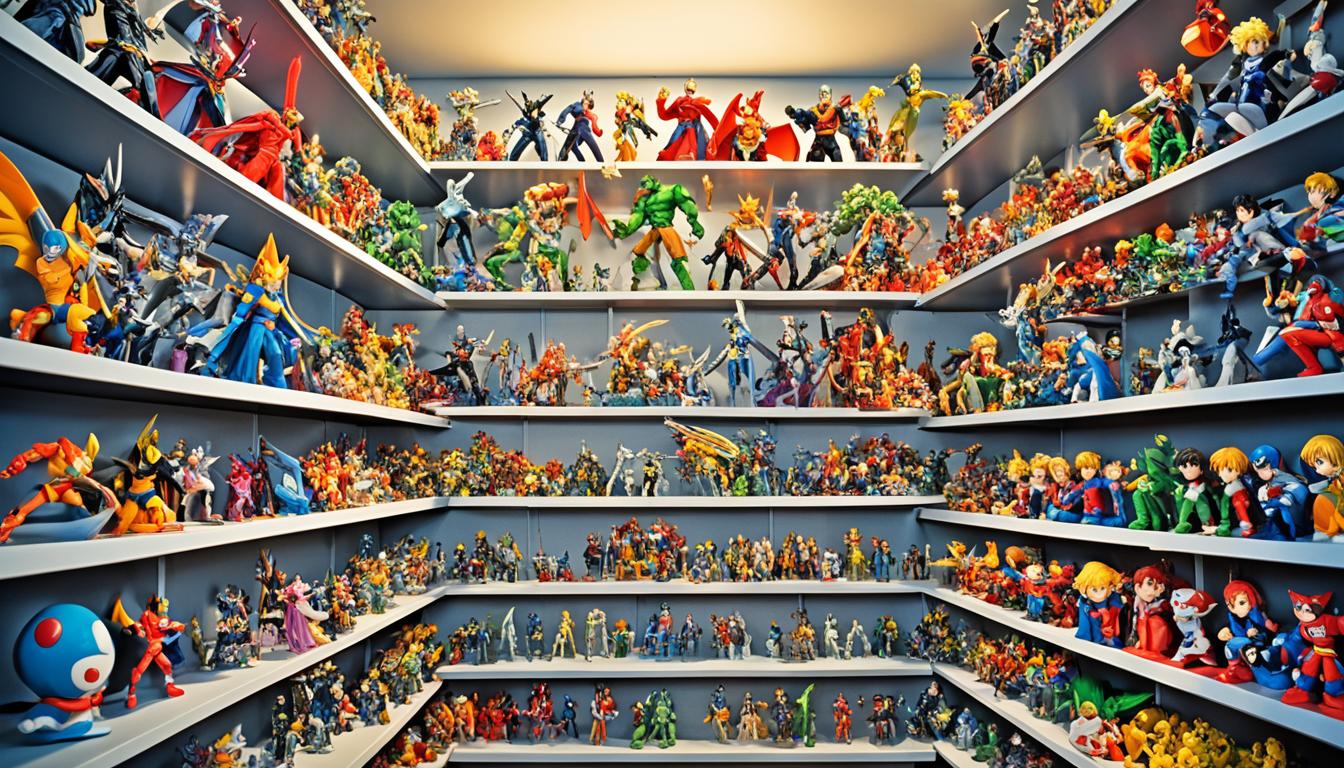Did you know otaku spend $2.5 billion yearly on their hobbies? This subculture is into anime, manga, and collectors’ items. They enjoy collecting things like rare figurines and limited-edition items that show off their love for anime and manga.
The otaku culture has grown with shows like Naruto and Dragon Ball Z. Popular series like Jujutsu Kaisen and My Hero Academia have also joined the list. Collecting figurines from these series has become very popular among otaku fans.
If you want to become a great figurine collector, don’t worry. This blog lists ten steps to help you. You’ll learn to choose themes, set budgets, and explore various figurine types. This guide will help you gather an amazing collection.
Key Takeaways:
- Otaku culture thrives on collecting, with enthusiasts spending $2.5 billion annually on their hobbies.
- Popular anime series like Naruto and Dragon Ball Z fuel the passion for collecting figurines.
- Following the provided steps can help you become a master anime figurine collector.
- Financial planning and knowledge are crucial in the otaku culture collecting community.
- Collecting anime figurines offers an emotional connection and nostalgia for fans.
- A diverse range of figurine types, such as Nendoroids and Scale Figures, cater to collectors’ preferences.
Otaku Culture and the Misunderstandings
Otaku culture is often misunderstood and stereotyped. People on the outside may see otaku as geeks. They connect otaku with being socially awkward. But this view doesn’t show the real heart of otaku culture.
Otaku consider themselves as masters in pop culture areas like manga and anime. They have a lot of knowledge and love for these subjects. This makes them more than just geeks. They dive deep into their favorite media, showing dedication and passion.
Many think otaku culture is only for those who have trouble fitting in. But, it is a space for people from all backgrounds. Plenty of otaku lead regular lives, full with work, family, and friends. They show that loving pop culture doesn’t mean being socially awkward.
We should value the know-how and passion otaku fans have. They really understand and love manga, anime, and games. Their love and knowledge help these art forms grow. By breaking myths and seeing otaku as experts, we can understand how diverse and colorful otaku culture truly is.
The Economic Impact of Otaku Culture
Otaku culture, driven by its devoted enthusiasts, makes a big economic splash. Fans, known as otaku, put a lot of money into their hobbies. This spending power shows how large their economic impact really is.
In a book called “Otaku Spaces,” a report found otaku spend about $2.5 billion each year. This spending is key to the community’s influence. It proves otaku culture is not just for a select few.
Many industries benefit from otaku, like anime, manga, and more. The demand for new content boosts these markets. Thus, otaku fans are a vital force behind their favorite hobbies’ growth.
The Internet and media have helped otaku culture grow. They offer a vast space for fans to find new favorites. This access increases consumption, benefiting the economy further.
Despite facing some critics, otaku’s economic impact is clear. Their spending helps various sectors and shows their broad influence. As a result, otaku enthusiasts are a significant part of today’s market.
As the otaku community expands, its economic role does too. With more global acceptance, otaku’s financial support will likely increase in the future. This includes everything from supporting industries to boosting cultural awareness.
| Year | Economic Impact |
|---|---|
| 2005 | ¥2 trillion (US$18 billion) |
The otaku impact in 2005 was pegged at a massive ¥2 trillion (US$18 billion). This shows how much otaku spending matters. It also hints at the cultural and financial possibilities of otaku culture.
Otaku culture’s effect goes beyond money. It also influences art and media widely. This cultural impact helps spread Japanese pop culture’s charm across the globe.
Understanding otaku culture’s financial role is vital. It shows how shared hobbies can shape big parts of society and culture. It’s proof of the collective strength in following common interests.
The Evolution of Otaku Stereotypes
Otaku culture has often been seen in a bad light, making its fans look unsociable and strange. This view started in 1989 with Tsutomu Miyazaki’s arrest. He was an otaku who did terrible things, making many believe all otakus were like him.
But things have begun to change. Media now shows more of the goodness and variety in the otaku world. Thanks to its rising popularity, media portrayals have become more accurate and positive. They now reflect the real depth and diversity of otaku interests.
Today, media often talks about otakus’ love and creativity. Instead of talking about their social skills, they show off all the cool things otakus do. This change shows how otakus are valuable in many different areas, like art and technology.
“Otaku culture is so much more than the negative stereotypes. It’s a celebration of individuality, creativity, and a shared love for anime, manga, and other aspects of popular culture.” – Keiko Tanaka, otaku enthusiast
The otaku world is now more accepted, and its fans are recognized for their many talents. They are in a range of professions, and being part of the subculture helps them to build strong communities. These communities are often both online and in person.
Even though some old views still linger, we can overcome them by highlighting the positive side of being an otaku. Doing so helps build a better understanding and respect for the diverse world of otaku fans.
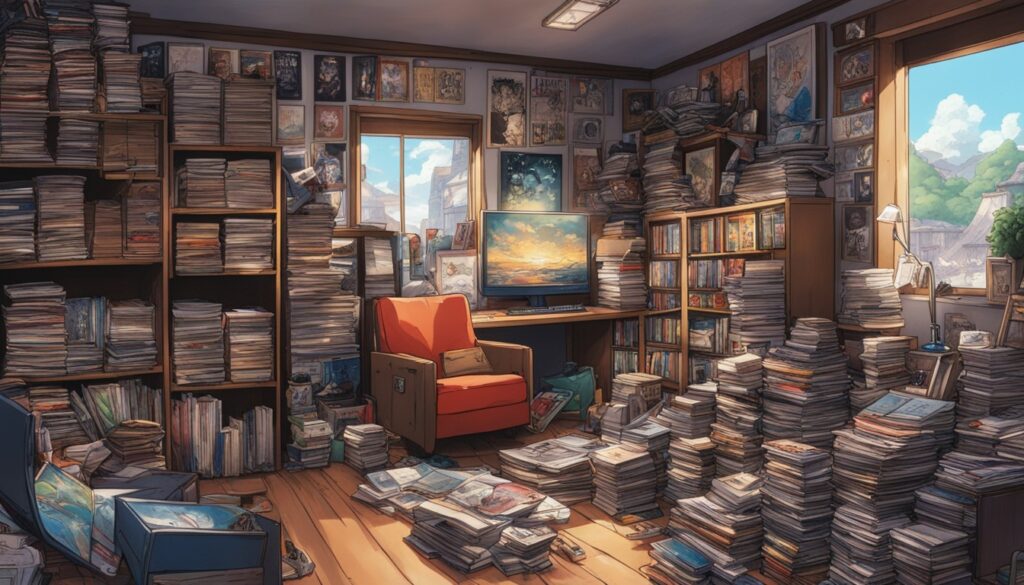
The Influence of Positive Media Representation
Positive media has played a big part in changing how otakus are seen. As otaku culture became more known, TV and films started to show a brighter side of it.
Now, we see shows that truly capture otakus’ love and dedication. They cover everything from collecting to cosplay. This change has been important in breaking the old, wrong ideas about otakus.
By focusing on the good and varied parts of being an otaku, the media is helping to create a more welcoming society. This is making a big impact in how people outside the otaku world see and accept it.
| Year | Event | Impact |
|---|---|---|
| 1989 | Arrest of Tsutomu Miyazaki | Reinforced negative stereotypes |
| 2005 | Presentation of the word “moe” nominated for You-Can Buzzword of the Year Award | Normalized “moe” in everyday conversation, easing the “otaku allergy” |
| 2019 | Highest attendance ever at Comiket with 730,000 visitors | Indicates a significant increase in individuals identifying as otaku |
| 2020 | SHIBUYA109 lab survey reveals 67% of respondents aged 15-24 identify as otaku | Demonstrates the prevalence of otaku culture among the younger generation |
- Keiko Tanaka, otaku enthusiast
- Patrick W. Galbraith, “Otaku Spaces”
- Toshio Okada, “Otaku wa sude ni shindeiru”
Otaku Spaces: Giving a Voice to the Community
Many people have the wrong ideas about otaku culture. But, in “Otaku Spaces,” Patrick W. Galbraith and Androniki Christodoulou show us a different view. They let otaku tell their own stories and experiences.
The book shares many personal interviews and great photos. It makes the otaku world more human and shows how varied their lives are. You’ll see rooms packed with collections that show their deep interests.
“My room is my sanctuary,” says one otaku. “It’s where I can fully immerse myself in my obsessions and feel a sense of belonging.”
The book aims to erase common stereotypes about otaku culture. By spotlighting a big range of otaku, Galbraith and Christodoulou show us they’re from all walks of life.
“Otaku Spaces” introduces us to real people behind the stereotypes. We meet comic and anime fans who show the passion and importance of their stuff. It’s a really eye-opening read.
Otaku love physical media, like DVDs and manga. Their shelves are proof of the dedication to their favorite stories. It’s impressive to see.
| Physical Media | Decorations | Obsessions |
|---|---|---|
| DVDs | Figures and merchandise | Anime, manga, video games |
| Blu-rays | Posters and artwork | Eroge and ero-doujinshi |
| Manga | 2D girls’ figures | Kujibiki Unbalance |
| Light novels | Display cases | |
| Magazines | ||
| Video game cartridges | ||
| CDs |
Otaku’s stuff can seem funny or crazy to others. But it’s all about love and dedication for them. Collecting is their way of showing how much they care about their favorite anime, manga, or games.
Breaking Stereotypes Through Personal Stories
“Otaku Spaces” shines a light on the real otaku world. It shows that otaku are not just introverted. They are a lively group who find connections through events and the internet.
Conventions and online places bring otaku together. “Otaku Spaces” shows us how creative and passionate they are. It’s a fresh look into their world.
The book shares many otaku stories. It shows their true colors and opens a window to their hearts and minds. Each story tells us something new about the otaku community.
Thanks to “Otaku Spaces,” otaku can speak up and change the way people see them. This book helps understand and value their deep love for their hobbies. It makes us appreciate them more.
Otaku Collecting: A Showcase of Obsession and Passion
Collecting is key to otaku culture, showing how much people love their hobbies. Otaku collectors find and gather items related to anime, manga, and games. These items show their strong love for otaku culture and act like precious symbols of it.
Otaku collectors are always looking for new things to add to their collection. They often collect figures, which are detailed models of their favorite characters. These figures are carefully made and show the character’s true spirit. Whether kept in their box or on a shelf, they are important to collectors.
Books and comics are also big in otaku collections. Manga, or Japanese comics, are a loved form of art. Otaku enjoy collecting manga which lets them enjoy the story and art at home. Artbooks are also popular, as they show the design work behind anime and manga stories.
Video games are another big part of otaku collections. They range from old classics to new popular games. By collecting games, otaku can enjoy their favorite series in different ways over time.
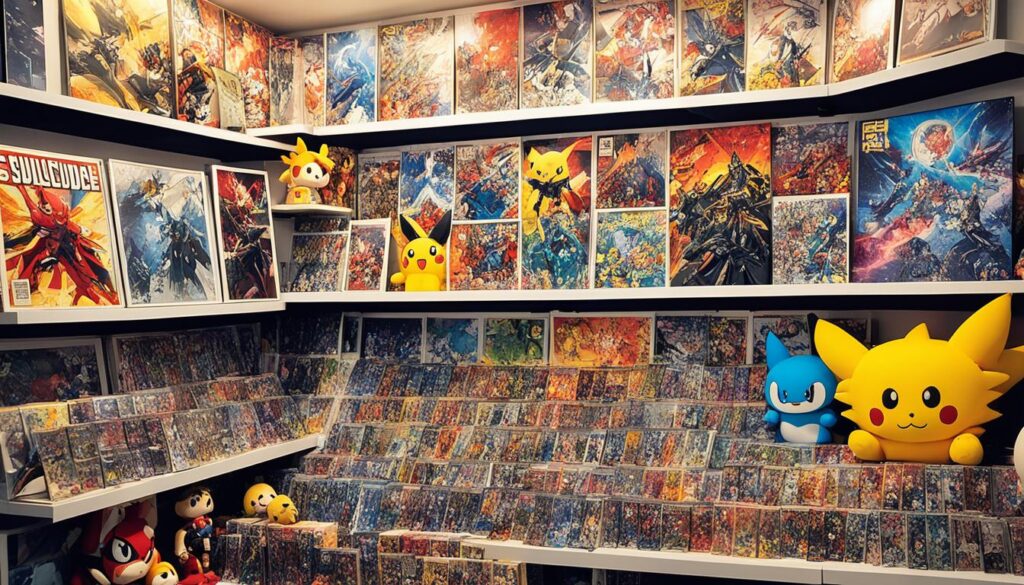
The effort and money that otaku put into their collections are very impressive. Some collectors search for rare items for years. Collectors can spend a lot of money on their collections, which they see as a symbol of their dedication.
For otaku, collecting is much more than just getting stuff. It shows their deep love for anime, manga, and games. Their collections show how much they enjoy these worlds and connect with others who love the same things.
Otaku Shops: The Gathering Places for Collectors
Otaku culture goes out beyond private spots. Collectors find a community in urban areas near unique shops. These otaku shops act as collection spots and also as a stage for things like cosplay. They’re like hubs, making the otaku life clear and easy for those into the subculture.
In Japan, the Nakano Broadway is known for its otaku and geeky goods. Since 1966, it has been a go-to place for nerds, with tons of items to please any collector.
At Mandarake in Nakano Broadway, otaku find everything they love. Specialty stores sell rare old comics, one-of-a-kind figures, fashion, media, and even snacks.
Some spots in Nakano Broadway sell luxury goods beside basic otaku items. This wide range attracts collectors of all kinds.
Nakano Broadway shines for its stash of old gems and new niche items. You won’t find this mix in other places. It’s the ultimate stop for everything otaku, from the classics to the latest, with a focus on unique finds.
These shops aren’t just for spending cash. They are social spaces that bring collectors together. They create a community where patrons, local and not, share their love and feel like they belong.
Late-Night Events and Beyond
Some shops host night events for the dedicated. The fun goes on until early morning, with games like Magic the Gathering drafts. This keeps the community vibe strong among fans.
But shops do more than sell. They are places where enthusiasts can gather, dress up (cosplay), and hang out. They give otaku a place to show off their creative sides and meet other fans.
Urban otaku shops are key for fan gatherings. They create spaces for forming friendships and sharing stories.
The Ultimate Otaku Shopping Experience
An otaku shop is where the details truly matter. They focus on the art of collecting with great care. They often have grading systems to rate collectibles, ensuring customers know the condition of what they’re buying.
This careful checking shows the devotion within the otaku world. It’s about deep love and attention to every piece.
Otaku Shops in Nakano Broadway
| Shop Name | Product Range |
|---|---|
| Mandarake | Rare comics, limited-edition figures, fashion, media, and food |
| Kotobukiya | Character figures, model kits, and merchandise |
| Animate | Anime DVDs, CDs, official merchandise, and manga |
| Sofmap | Electronics, games, computer software, and merchandise |
| Movin’ Anime | Rare anime DVDs, Blu-rays, and merchandise |
Nakano Broadway’s otaku shops are a collector’s heaven. They offer a wide array of products and build a strong community of fans who love anime, manga, and more.
Takashi Murakami: Otaku Influence in Art
Renowned artist Takashi Murakami has brought the world of otaku into contemporary art. He was born in Tokyo, Japan, in 1962. Murakami blends elements of Japanese pop culture with its rich artistic history. This fusion breaks down the barrier between consumer goods and fine art.
The Superflat Movement
Murakami created the term “superflat” to explain his art style. It shows the mix of art and business. He draws from kawaii culture, which is big in Japan, especially among the young. His art is full of bright colors and themes from anime. It’s seen as attractive but also critical of today’s culture, in Japan and the West. While some see Superflat as a simple view of Japan, it has also inspired many in Japanese art today.
“I consider my artwork a form of revenge against Western interventions in Japan.” – Takashi Murakami
Murakami’s Impact on Pop Culture
Murakami has a unique style that mixes elements of high and low art. He’s known globally for this. Artists like him take ideas from everyday culture, like cartoons and stuff we buy. His work with Marc Jacobs for Louis Vuitton in 2003 was a big hit. It showed how art and business can blend in new ways.
The Murakami Universe
Murakami doesn’t just do fine art. He also makes a lot of things people can use every day, like mugs and T-shirts. These items make his artwork part of people’s daily lives. He sells both expensive art and cheap souvenirs, which is quite unique in the art world.
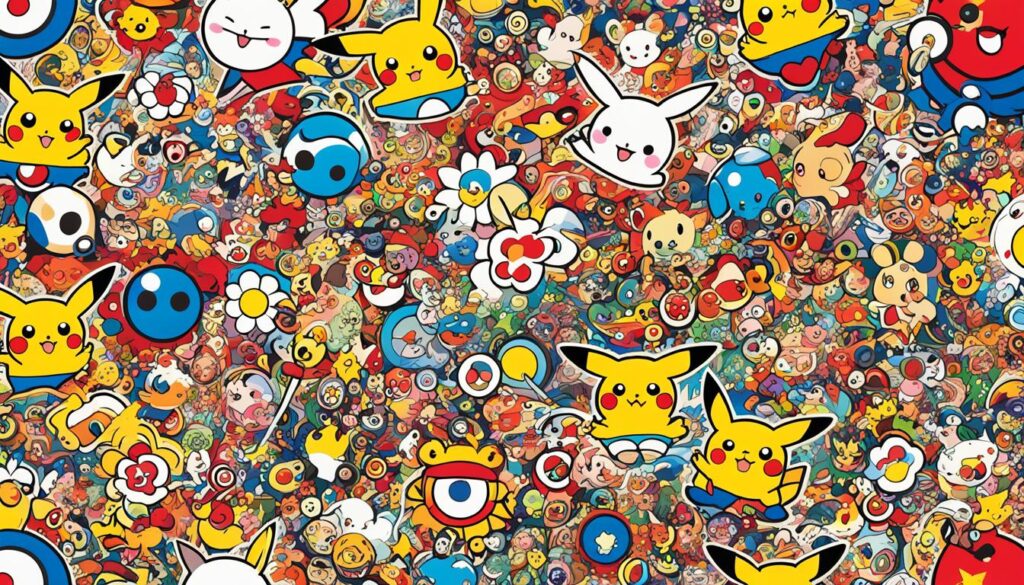
Exhibition: “Murakami vs. Murakami”
The impact of Murakami is clear in the “Murakami vs. Murakami” exhibit in Hong Kong. It has a special room with items from his personal art collection. This exhibit, now at the Tai Kwun Centre for Heritage and Arts, shows Murakami’s long-lasting influence on art.
In conclusion, Murakami has changed the way we see art by fusing it with otaku culture. His work has inspired a new wave of Japanese artists. With his distinct style and many successful projects, Murakami has become a leading figure in the art world.
Otaku Influence in Fashion and Design
Otaku culture has greatly impacted the fashion and design world. We see artists and designers using anime and manga in their work. This blend has led to outstanding and engaging designs that attract fans.
KAWS is a prime example, merging otaku culture with his iconic figures. He has partnered with brands like Louis Vuitton and Supreme, adding anime style. This mix delights both otaku and fashion fans.
Anime is also influencing mainstream fashion. Its art, animation, and music have appeared in popular culture, making fashion trends. This mix is bringing innovation and excitement to design and fashion.
Designer’s Studio and Home in Chinatown
Yumin Ha is a designer tying otaku influence into their work. They work from their studio in Chinatown. Their work reflects not just the neighborhood but series like Giant Robo OVA and Yotsuba.
Living in Chinatown helps shape Yumin Ha’s unique style. However, concerns arise over gentrification, affecting local creativity. This might block the birth of new otaku-inspired designs.
From Bootleg to High-End Fashion Pieces
Otaku influence in fashion is shifting. Big brands are now keen on working with Japanese animation. For instance, Gucci teamed up with Doraemon and Loewe with Spirited Away.
There’s now a quick rise in people wanting otaku-themed items. This growth has moved otaku culture from low-priced items to luxurious fashion. It shows the powerful cultural and commercial effect otaku is having.
Yumin Ha: Anime, Manga, and East Asian Pop Culture Influences
Yumin Ha’s brand is at the forefront of otaku fashion. They combine anime, manga, and pop culture into their items, appealing to otaku fans. They offer quality at affordable prices.
The influence of manga, video games, and East Asian cinema can be seen in Yumin Ha’s creations. This sets their brand apart. Their approach celebrates these cultural elements, guiding their journey and influencing wider fashion trends.
Otaku culture is firmly rooting in fashion and design. With more collaborations and unique designs, it’s capturing a wider audience. The impact of otaku on fashion is growing and changing, promising more exciting trends in the future.
Otaku Influence in Music
Otaku culture has greatly impacted the music world, especially in hip-hop. Many artists use otaku themes in their music. This creates a cool mix of different styles and sounds.
Sampling, a key technique in hip-hop, shows the otaku influence well. Artists often use anime sounds and famous Japanese musicians’ music in their songs. This makes their music feel familiar to otaku fans.
Artists like RZA, Ghostface Killah, and Flying Lotus mix otaku culture into their music beautifully. They show love for their favorite anime, manga, and video games in their songs.
“Sampling lets me combine two things I love—hip-hop and anime. It’s like making a music project that celebrates both cultures.” – RZA
By blending otaku culture in their music, these artists connect with fans. They also introduce more people to otaku world, making it more popular.
The Global Impact of Anime Music
Anime music is loved worldwide, not just in Japan. Songs from anime themes are especially popular, with millions of fans listening on Spotify.
For instance, the song “Guren No Yumiya” from Attack on Titan has over 13 million plays. “Unravel” from Tokyo Ghoul has more than 11.6 million streams. These numbers show how much people enjoy anime music.
The band FLOW has over 25 million streams on Spotify with their anime songs. This shows the big interest in anime music worldwide.
Japanese Music Crossing Over
Collaborations between Japanese and global musicians show how music goes beyond borders. The song “Red Swan” by X Japan’s YOSHIKI and HYDE is a great example. It has gained fans all over the world.
Platforms like Spotify help Japanese music reach people globally. The interest in anime helps Japanese musicians find new fans around the world.
Image related to otaku influence in music:
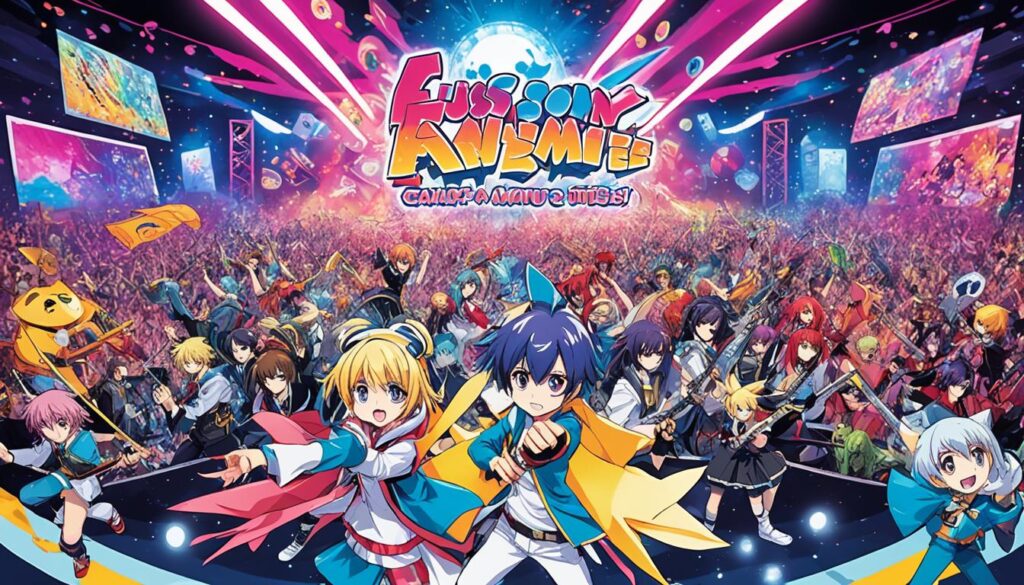
Otaku Influence in Popular Culture
Otaku culture shows up a lot in popular culture these days. It’s in TV shows like “The Boondocks,” with its anime look. Also, in music and fashion, we see Western and Japanese creators working together. This mash-up between cultures is everywhere, shaping our world today.
You can see how much otaku culture affects media just by looking. Anime and manga looks have seeped into TV, movies, and even what we wear. The bright colors and unique characters are hard to miss.
But it’s more than just looks. Think about how Western music and Japan’s creativity mix. Pharrell Williams and Hatsune Miku did something special with “Last Night, Good Night (Re:Dialed).” Their work shows how otaku influences can bring people together.
Hip-hop is also making a place for otaku culture. Members of the Wu-Tang Clan, like RZA, and Tyler the Creator, take ideas from Japanese pop culture. They use these in their music, adding their unique flavor.
“Hip-hop artists like Lupe Fiasco, Childish Gambino, Lil Uzi Vert, and Nicki Minaj have incorporated elements of Japanese pop and otaku culture into their works.”
Now, this mix is making waves in fashion too. Luxury brands are teaming up with designers like KAWS. They’re using cool anime figures in their designs. It’s a hit, loved by those who enjoy art and those who stand out in fashion.
This all shows just how big otaku culture is in our lives. It affects what we watch, listen to, and even what we wear. With its growing influence, otaku culture will shape our world even more in the future.
| Key Points | Statistics |
|---|---|
| Otaku culture has influenced various creative industries and media. | – The late 1990s and early 2000s saw the global rise of Japanese popular culture, including otaku culture. |
| Collaborations between Western artists and Japanese creators showcase the fusion of cultures. | – Several Western artists, including Pharrell Williams, have collaborated with Japanese creators like Hatsune Miku. |
| Anime aesthetics have permeated TV shows, movies, and fashion. | – Anime-inspired artwork and animation are featured in TV shows like “The Boondocks.” |
| Hip-hop artists have incorporated otaku elements into their music. | – Hip-hop artists like RZA and Tyler the Creator have drawn inspiration from Japanese pop culture. |
| Collaborations between high fashion and otaku culture have gained recognition. | – Fashion designers like KAWS have collaborated with luxury brands, infusing their creations with anime-inspired characters. |
The Rich Variety of Otaku Culture
Otaku culture is a diverse and lively subculture. It includes many different hobbies and interests. This range allows people to deeply engage with what they love. It also helps them find others who share their passions.
Collecting is key in otaku culture. Fans gather tons of anime items, manga, and more. These collections show their deep love for these things and highlight their dedication.
Cosplay is very famous within otaku culture. It’s when people dress as characters from anime, manga, or games. They show off their skills and creativity by bringing characters to life. They often do this at events and conventions.
Idol culture is also big in otaku culture. Fans support their favorite idol groups in various ways. This includes going to concerts, buying items, and doing fan activities. It makes for a tight-knit community with a shared love.
Anime and manga are at the heart of otaku culture. They inspire great passion and stimulate creativity. With so many genres and styles, there’s something for everyone here. This media helps fans connect in meaningful ways.
Video gaming is crucial for otakus too. Gamers dive into virtual worlds filled with complex stories and gameplay. They join online groups, participate in competitions, and collect gaming items.
Otaku culture is incredibly diverse, attracting many around the world. Through their expressions of creativity and passion, otaku culture remains energetic and evolving. It keeps bringing in new fans and influencing global art and creativity.
The Power of Passion and Community
In otaku culture, passion, creativity, and community are key. They bring life to this diverse subculture. Otaku enthusiasts find belonging through shared interests and dedication.
Passion is the fuel for the otaku community. It drives their love for anime, manga, and more. This same passion encourages them to do things like cosplay and perform.
This shared enthusiasm creates a tight-knit community. Otaku gather at conventions and online. Here, they celebrate their interests, share ideas, and make friends from all over.
According to Jim Heckman, success isn’t just about IQ. Things like passion and character are just as important. They help you achieve your goals and feel fulfilled.
Angela Duckworth adds that talent can be grown with time and hard work. This is at the heart of the otaku ethos. They keep learning and enhancing their fandom knowledge.
“Interest and values are more decisive factors than salary in sustaining long-term effort and passion. Following one’s passion becomes a key element of success and satisfaction in work and life,” says Duckworth.
Otaku show how you can improve personal traits like grit and dedication. These can be learned or partly from genetics. They’ve built a culture that values passion, aiding in personal and continuous growth.
The impact of passion and community isn’t just in otaku culture. In many areas, those driven by passion and supported by their communities excel. They find real success and joy in their work.
By doing what they love and connecting with others, otaku enthusiasts influence others. They encourage more engagement in one’s interests. This leads to creativity, personal growth, and a strong sense of belonging for everyone.
Conclusion
Otaku culture celebrates collecting and fandom delights. It’s filled with passionate fans who love everything from anime to manga. Their activities like cosplay and performance shape a dynamic cultural world. This world is always changing, inspiring newer fans.
Collectors show their love by gathering special items over time. This process reflects their deep connection to the creativity in their collections. Every item in their collection tells a story of commitment and love for their chosen series.
Otaku culture brings fans together, creating a sense of community. Here, those with similar interests bond, share, and form strong relationships. It’s a place that supports creativity, allowing fans to showcase their art through cosplay, performances, and more.
Beyond individuals, otaku culture influences many creative industries worldwide. It has touched art, design, fashion, and music. Famous figures like Takashi Murakami and collaborations with brands like KAWS show how powerful otaku culture has become. It’s widely recognized and appreciated in these sectors.
FAQ
What is otaku culture?
Otaku culture is a unique subculture that loves anime, manga, and other geeky stuff. It’s a community of fans who celebrate these subjects.
How is collecting significant in otaku culture?
Collecting is key in otaku culture. Fans collect anime, manga, and other items that they love. It shows their deep passion for these interests.
Are otaku limited to socially awkward individuals?
Many think otaku are only shy and awkward. But, that’s not true. Lots of otaku are outgoing, living normal lives with families and friends.
What is the economic impact of otaku culture?
Otaku fans worldwide spend about .5 billion each year on their hobbies. This spending shows how large and influential the otaku community is.
How have otaku stereotypes evolved over the years?
Media views of otaku have changed. They’re now seen more positively, as part of a diverse and social subculture. This challenges old, negative views.
What is “Otaku Spaces” about?
“Otaku Spaces” is a book that gives otaku a voice. It shows their personal spaces and stories through interviews and photos, breaking stereotypes.
What do otaku collectors amass in their collections?
Otaku fans collect a variety of items. This includes anime toys, soundtrack CDs, manga, and video games, among other things.
Where do otaku collectors find a sense of community?
They connect in cities at specialized shops. These shops are more than stores; they’re places where otaku meet, cosplay, and enjoy their hobbies together.
Who is Takashi Murakami and how has he influenced otaku culture?
Takashi Murakami is a famous artist. He gets his inspiration from otaku culture. His art is colorful and shows anime influences.
How has otaku culture influenced fashion and design?
It’s had a big impact on fashion and design. Anime and manga often inspire clothing and accessories. There are even collaborations with high-end brands.
How has otaku culture influenced music?
In music, otaku culture is seen in hip-hop. Songs often feature anime sounds and Japanese music. This mixing creates unique musical styles.
How has otaku culture influenced popular culture?
Otaku culture has changed pop culture worldwide. Its influence is in TV, art, and media. Often, it’s seen in collaboration projects.
What aspects make otaku culture diverse?
Otaku culture is rich in diversity. It includes many activities like collecting and cosplay. This lets fans truly engage with their favorite hobbies.
What is the power of passion and community in otaku culture?
Passion and community are at the heart of otaku culture. The love for anime and manga connects fans worldwide. It builds a supportive and global community.
